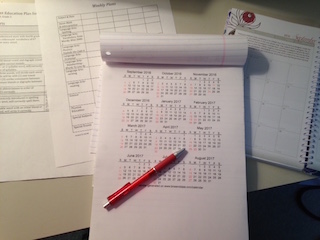4 steps to plan a great homeschool year

By Kathy Kuhl
Got a plan?
You’ve set your goals,* you’ve ordered your curriculum, and the boxes have arrived. You have another stack of books and materials you bought at a homeschool convention. It feels a bit like the holidays, with all the new books piled up like promising packages. But now what?

(*No written goals yet? Sign up for my newsletter to get my free Goal-setting Guide.)
Before you start teaching, it’s time to plan.
But how can we plan a year of teaching a child who learns differently? Some of our kids learn it today, and forget it tomorrow. Then they will recall it one day next week. Argh!
Some of us have kids who will be hospitalized. Some of us work our homeschool around our kids’ therapy schedule: speech therapist on Tuesdays, occupational therapist Wednesday, counselor Friday.
And we all know that no matter how we plan, it won’t happen that quite way, so why bother?
Why plan?
Aim at nothing and you will hit it. Unless your child’s needs are so severe that you must plan on the spot each day, some planning will help you.
Even teaching kids with severe needs, at least some high-level planning will help you with that last minute daily planning you may need to do. Your plans can include plans for good days, and back-up plans.
One mother I interviewed for Homeschooling Your Struggling Learner said that if her son was heading toward a meltdown, sometimes she would declare a photography day, and let him get outside with his beloved camera. Another mom was grateful to homeschool because if a night of mini-seizures kept her daughter up all night, she could nap the following day, without missing a day in a classroom.
Remember the plan is your servant, not your master. I don’t encourage you to write plans because I want you to feel guilty when you don’t reach your goals. (I’ve tried feeling guilty and I don’t recommend it.) I want you to celebrate your successes. In your busy lives, I want you to have an easy way to remind yourself what you are aiming for.
Like a good shopping list, a plan for teaching an exceptional child helps you get through the week more efficiently. A complete shopping list doesn’t keep you from spotting bargains. It helps you make better choices. As shopping list helps you get through the grocery store more quickly, a good plan for your year, month, and week helps you remember what you came for.
As I read a post on Heather Bowen’s blog, the inspiration for this series, I realized how much she and I have in common and how we differ. Heather and I love to plan.
But I have to watch that I don’t fiddle too much. My ADD-like tendency to hyperfocus means I’ll delight in tweaking margins and fonts, but neglect to start the laundry!
How to plan: my 10 steps (Four this week)
- First, write in pencil or on a computer, but pencil and paper is probably better for helping you think. Don’t write in pen, unless it’s to mark unchangeable things like birthdates and holidays. Other dates will change.
- Use a nine or twelve-month calendar. I customize and download one from timeanddate.com.
- Next, plan the dates you plan to teach. Consider:
- Does your state or province require you to homeschool a certain number of days per year?
- When will you homeschool? Late August to May? Start after Labor Day? I have a friend living abroad who starts her academic year in March, after a favorite education conference. It inspires her.
Or will you homeschool year round, taking 1-3 weeks off now and then? It’s fun and economical to vacation while other children are in school, or to piggyback a vacation on a parent’s business trip. (That’s how we took our kids to England.) - Will a parent be deployed or come home during your homeschool year? You will want to build in some time off around that. Transitions may be easier if you have homeschool at least part of the days to give the time some structure.

Homeschooling is easier when you both know you have a plan–even though you’ll change it. - Don’t forget the floating holidays. Decide if you will take Columbus Day off, for example.
Hint: check and see if your co-op is. Don’t assume. Our co-op leaders get calls from surprised parents: “I thought you would take Monday off–we’ve planned a trip.” Oops. - Do you need or want to take the whole week of Thanksgiving off for travel or to prepare for out-of-town visitors?
- What about Easter and spring break? Will they occur at the same time? If you have older children coming home from college or taking community college classes, you should have their vacation dates on your homeschool calendar, too. It will be harder for the young ones to work when the beloved big sister or brother has just rolled in.
- Then look over your calendar for long stretches with no holidays. Do you need to add one? (I’m sure that’s one reason why kindergarten classes celebrate the hundredth day of school.)
- Put in some slack. Someone will get sick, some will have meltdowns, some will fall behind, so allow some make up days and some slack. If your state or province requires 180 days of home instruction, as my state does, don’t plan a big trip for the 181st day if you can avoid it. Give yourself a few days of cushion.
4. After you’ve got your days set, next think about holidays. What workload is reasonable around holidays? Will you have houseguests? Special events or performances? When my son was a small, highly distractible boy, I realized that for him Christmas and his birthday afterwards were so exciting that he couldn’t make much progress academically for a few weeks.
Once I accepted that, I could plan more art and music activities, more games that reviewed basic skills, and more crafts and cooking. (He made candy for his scoutmaster, swim teacher, and karate teacher.)
See more in part two of this post, and more in my book, Homeschooling Your Struggling Learner.
What tools help you plan? Please answer in the comments section below.


